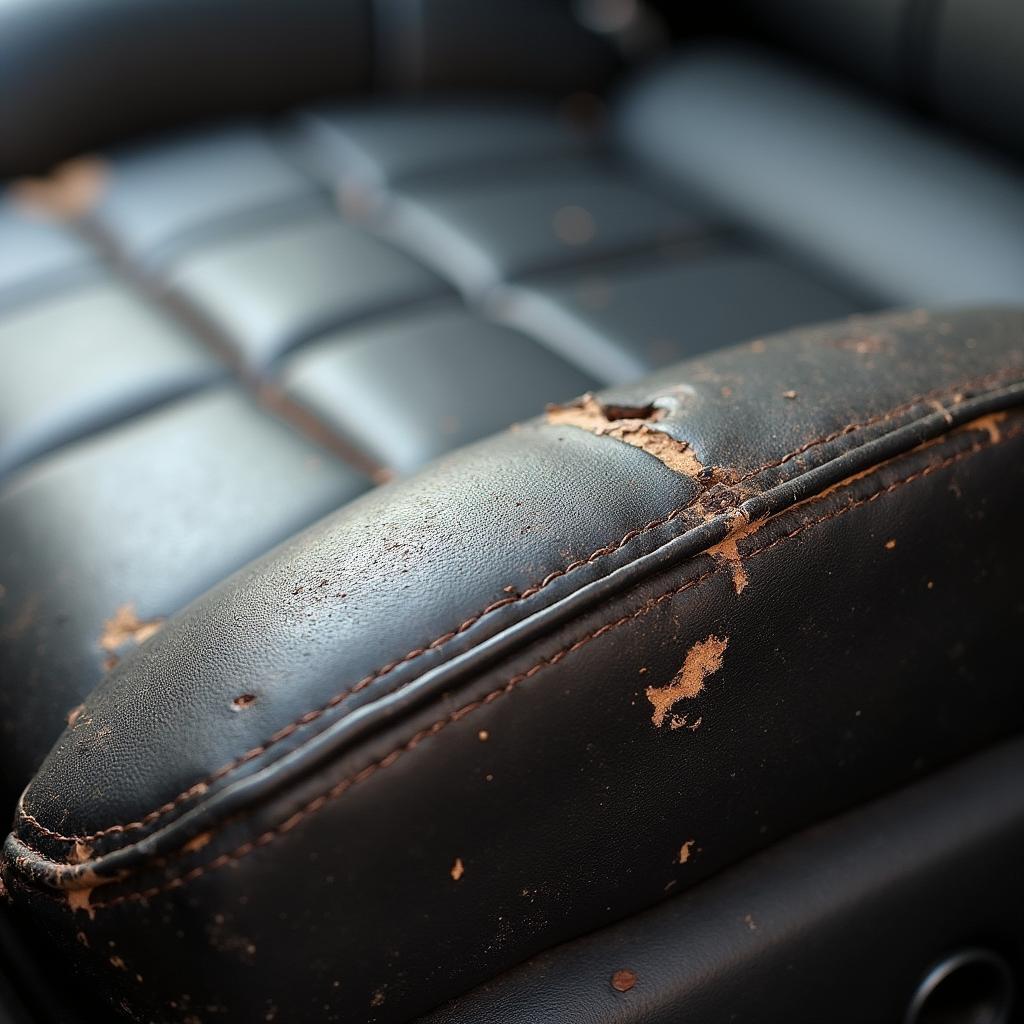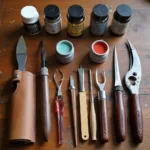Leather car seats are a luxurious and comfortable addition to any vehicle. However, over time, leather can become dry, cracked, and faded if not properly cared for. This can not only affect the appearance of your car’s interior but also decrease the lifespan of your leather seats. But don’t worry, restoring your leather seats to their former glory is possible with the right approach. This comprehensive guide will provide you with a step-by-step walkthrough on how to repair dry leather car seats, ensuring they look their best for years to come.
Understanding Why Leather Seats Dry Out
Before diving into the repair process, it’s important to understand the reasons behind dry leather car seats.
-
Exposure to Sunlight: Prolonged exposure to the sun’s UV rays is a primary culprit. UV radiation can break down the natural oils present in leather, leading to dryness, fading, and cracks.
-
Heat: Similar to sunlight, excessive heat can also dehydrate leather. Parking your car in direct sunlight, especially during hot summer months, can significantly accelerate the drying process.
-
Lack of Conditioning: Leather, like our skin, needs regular moisturizing. Neglecting to condition your leather seats regularly strips them of essential moisture, leaving them susceptible to dryness and cracking.
-
Harsh Cleaning Products: Using harsh chemicals or household cleaners on your leather seats can strip away their natural oils, making them dry and brittle over time.
How to Repair Dry Leather Car Seats: A Step-by-Step Guide
Bringing back the suppleness and shine to your dry leather car seats is achievable with a little effort and the right products. Follow these steps to learn how to effectively repair dry leather car seats:
1. Gather Your Supplies:
-
Leather Cleaner: Opt for a dedicated leather cleaner that is pH-neutral and free of harsh chemicals. Avoid using household cleaners or saddle soap, as these can damage the leather.
-
Leather Conditioner: Choose a high-quality leather conditioner that is specifically designed to moisturize and protect leather. Look for conditioners that contain natural oils and UV protectants.
-
Microfiber Cloths: These are essential for applying and buffing both the cleaner and conditioner. Microfiber cloths are soft and lint-free, ensuring a gentle and effective cleaning process.
-
Soft Bristled Brush: A soft-bristled brush can come in handy for cleaning crevices and hard-to-reach areas. Ensure the bristles are soft enough to avoid scratching the leather.
-
Leather Repair Kit (Optional): For deeper cracks and scratches, consider using a leather repair kit. These kits usually contain filler compounds, colorants, and tools to help you repair more significant damage.
2. Prepare Your Workspace:
-
Park your car in a shaded area. This will prevent the leather from heating up too quickly during the cleaning and conditioning process.
-
Open the car doors and windows to ensure proper ventilation.
3. Clean the Leather Seats Thoroughly:
-
Vacuum the seats: Begin by vacuuming the seats thoroughly to remove any loose dirt, dust, or debris.
-
Apply Leather Cleaner: Spray the leather cleaner onto a microfiber cloth and wipe down the seats in a gentle, circular motion. Avoid soaking the leather, as excessive moisture can be damaging.
-
Pay attention to crevices and stitching: Use the soft-bristled brush to clean any dirt or grime trapped in crevices and stitching.
-
Wipe away residue: Once you’ve cleaned the entire seat, use a clean microfiber cloth to wipe away any remaining cleaner residue.
4. Condition the Leather Seats:
-
Apply Leather Conditioner: After cleaning, apply a generous amount of leather conditioner onto a clean microfiber cloth.
-
Massage the conditioner into the leather: Work the conditioner into the leather using circular motions, ensuring even coverage. Pay extra attention to dry or cracked areas.
-
Let the conditioner soak in: Allow the conditioner to sit on the leather for the amount of time recommended on the product label. This will allow the leather to fully absorb the moisturizing agents.
-
Buff the Seats: After the recommended soaking time, use a clean microfiber cloth to buff the seats gently. This will remove any excess conditioner and leave a nice, even shine.
5. Repeat Regularly:
- To maintain the suppleness and appearance of your leather car seats, repeat the cleaning and conditioning process every 3-6 months, or more frequently if you live in a hot or sunny climate.
how to correctly repair damaged and cracked car leather seats for a more in-depth guide on addressing specific leather issues.
Preventing Future Dryness in Leather Car Seats
Prevention is key when it comes to maintaining the pristine condition of your leather car seats. Here are some proactive measures to prevent future dryness and damage:
-
Regular Parking Habits: Whenever possible, park your car in a shaded area or use a sunshade to minimize direct sunlight exposure. This will significantly reduce the damaging effects of UV radiation and heat.
-
Invest in Seat Covers: Consider using breathable seat covers, especially during extremely hot weather, to provide an extra layer of protection from the sun’s heat.
-
Promptly Address Spills: Leather is porous, meaning it can absorb liquids easily. If a spill occurs, address it immediately by blotting the liquid with a clean cloth. Avoid rubbing, as this can spread the spill and damage the leather.
-
Maintain a Consistent Cleaning Schedule: Make it a habit to clean and condition your leather car seats regularly. Establishing a routine will ensure that your seats receive the necessary care and protection to prevent dryness and cracking.
how to repair torn car seat fabric to learn how to address different types of car seat damage.
Conclusion
Knowing how to repair dry leather car seats is essential for maintaining the beauty and longevity of your vehicle’s interior. By following these steps and implementing preventive measures, you can restore your leather seats to their former glory and keep them looking their best for years to come. Remember, regular cleaning, conditioning, and protection from the elements are key to enjoying supple, luxurious leather car seats. If you encounter more severe damage or are unsure about any aspect of the repair process, it’s always best to consult with a professional auto detailer or upholstery specialist.
FAQ
Can I use home remedies like olive oil or coconut oil to condition my leather car seats?
While home remedies might seem tempting, it’s best to avoid using them on your leather car seats. These substances can penetrate the leather’s pores and potentially cause discoloration, stickiness, or even attract dirt and dust over time. Opt for dedicated leather conditioners that are formulated for this specific purpose.
How often should I condition my leather car seats?
A general rule of thumb is to condition your leather car seats every 3-6 months. However, the frequency may vary depending on factors like climate, usage, and the condition of your leather. If you live in a hot or sunny climate, you might need to condition them more often.
Can I use a leather repair kit on my own, or should I hire a professional?
If the damage on your leather car seats is minor, such as small cracks or scratches, you can try using a leather repair kit on your own. However, for more extensive damage or if you’re unsure about the process, it’s best to seek professional help. Professionals have the expertise and tools to ensure a seamless repair.
How can I prevent my leather car seats from fading in the sun?
Parking in the shade and using sunshades are effective ways to prevent fading. Additionally, using a leather conditioner with UV protectants can create a barrier against harmful UV rays.
What should I do if I spill something on my leather car seats?
Act quickly! Blot the spill immediately with a clean, absorbent cloth. Avoid rubbing, as it can spread the stain. If the spill is more stubborn, use a leather cleaner specifically designed to tackle spills.
For more detailed information on specific leather car seat repair techniques, check out our other informative articles:
Don’t hesitate to reach out for expert assistance with your car repairs and maintenance. Contact us via WhatsApp at +1(641)206-8880 or email us at [email protected]. Our dedicated customer support team is available 24/7 to address your inquiries.



